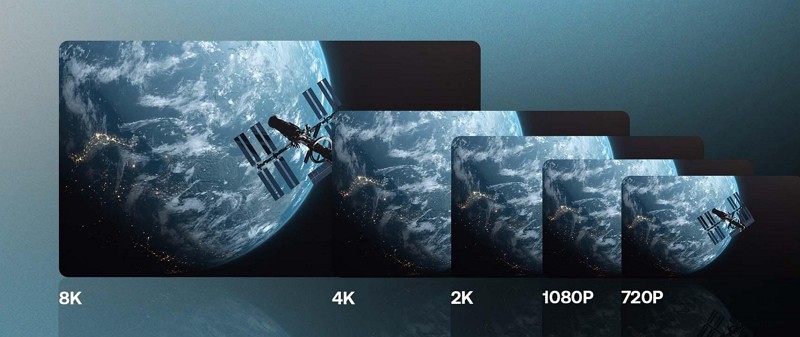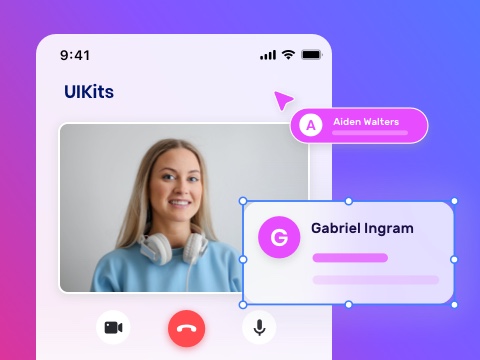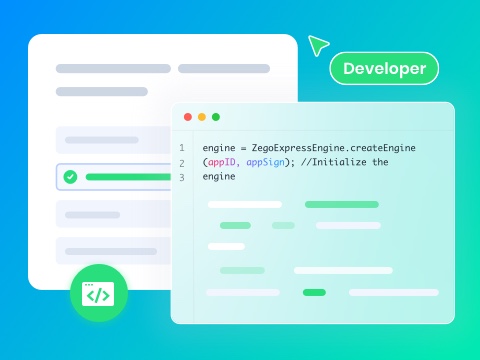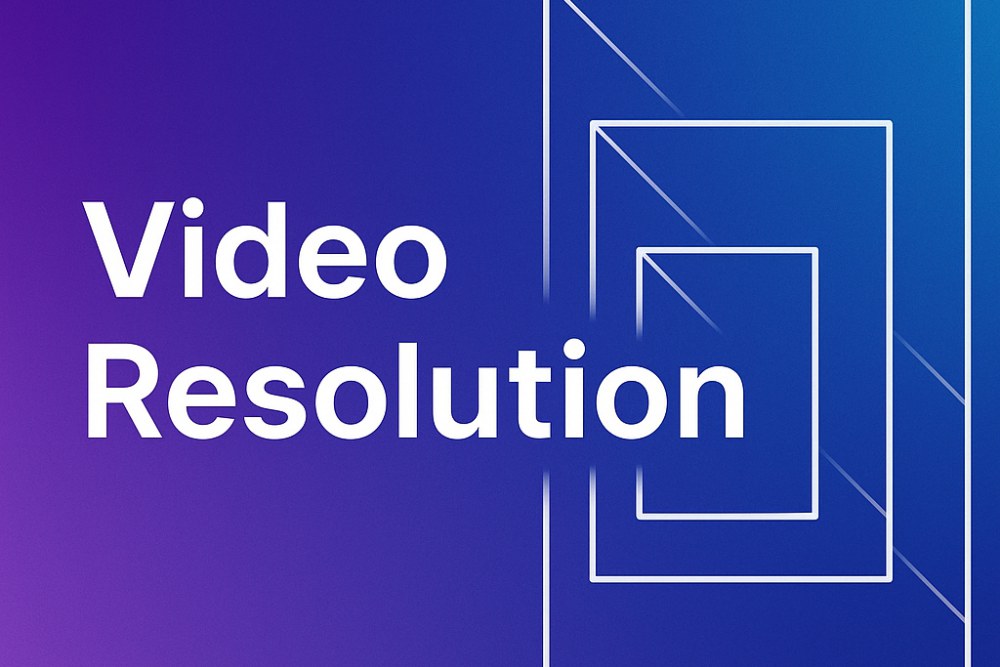The quality of the video actually influences the user’s experience with the product. Video resolution to developers is not just an aspect of technology, but it is the key to the immersion of content. Between maximizing the streaming capabilities and having sharp images on all devices, it is essential to master resolution. Thus, in this guide, you will learn about this term in detail as you explore its various forms.
What is Video Resolution?
Video resolution refers to the number of small dots, known as pixels, in a video image. A video with a higher number of pixels appears sharper and clearer. Resolution also alters the appearance of a video on various devices and its fluidity.
Developers should select the right resolution to ensure videos are clear, compatible with all devices, and load quickly. Therefore, with the knowledge of how the resolution works, developers can optimize videos to provide a high-quality and immersive experience.

Key Metrics Developers Should Know About Video Resolution
It does not matter whether you work with 2K video resolution or 5K video resolution, but you should be aware of the key video metrics. Being aware of these factors enables developers to produce a video that appears stunning, runs efficiently, and keeps the audience entertained.
Resolution Metrics
1. Pixel Dimensions
This shows the width and height of a video in pixels, and some common examples are:
- 720p (1280×720)
- 1080p (1920×1080)
- 4K (3840×2160)
- 8K (7680×4320)
So, when there are more pixels, the video will be clearer and sharper.
2. Aspect Ratio
It represents the relationship between the width and height of a video. Therefore, the common size of a modern video is 16:9.
3. Frame Rate
The frame rate is expressed in frames per second (fps) and determines how realistic the motion appears. Hence, 60fps makes the motion appear too real.
Quality Metrics
- Bitrate: While learning the resolution of video formats, know that it’s the amount of data processed per second. If you have a higher bitrate, it will improve the video quality but requires more bandwidth.
- PSNR: The Peak Signal to Noise Ratio is also known as PSNR and is used to determine the degree to which the compressed video is similar to the original. Hence, if the value is higher, it means that the video is of better quality.
- SSIM: The Structural Similarity Index displays the effect of compression on the appearance of the video to the viewers.
- VMAF: Video Multi-Method Assessment Fusion is the most popular method for streaming sites. Thus, it combines multiple quality measures to predict the actual viewer experience in the real world.
Quality of Experience Metrics
- Rebuffering Rate: While choosing the standard video resolution, this rate measures how often and for how long the video pauses to load. Therefore, if the creators’ video has lower rates, it results in a better viewing experience.
- Startup Time: This is the duration of time the video takes to start after pressing the Play button. The shorter time to start up is helpful to maintain the attention of the viewers.
- Playback Error Rate: It tracks the errors that occur during loading or playback, which can impact the video and viewing experience.
- Visual Artifacts: These refer to issues such as blockiness, blurriness, or faded colors that can reduce the overall video clarity and quality.
Different Types of Video Resolutions
You might have just heard about video resolution 720p, but the video resolution goes beyond that. Hence, if you want to know other types of video resolution, adhere to the given details for better clarity:
1. Standard Definition
It is one of the earliest and basic video resolutions, and it typically has the resolution of 720×480 pixels (for NTSC) or 720×576 pixels (for PAL). Hence, these types of videos are lower in quality but require less storage and bandwidth. Thus, this makes it suitable for older devices, small screens, or low data environments, but it is not commonly used today.
2. High Definition
This type of video resolution is usually at 1280×720 pixels (720p), and one can use it in online streaming or YouTube videos. HD videos deliver clear visuals and are ideal for modern displays. Moreover, while maintaining smooth playback without overloading networks, such videos strike a balance between quality and file size.
3. Full High Definition
It’s the 1080p video resolution that has a resolution of 1920×1080 pixels and offers high-quality visuals. Hence, it is suitable for large screens, gaming, and professional video work, although it requires more space and a fast internet connection. It is also used by most streaming services, Blu-ray discs, and cameras, providing a clear viewing experience.
4. 2K Resolution
This is 2048×1080 pixels, slightly broader than Full HD, and is applicable in digital cinema, professional filmmaking, and post-production. Besides, it consumes less bandwidth compared to 4K and trades quality and speed.
5. 4K Resolution
The 4K video resolution contains 3840 x 2160 pixels and provides four times the detail compared to Full HD. Due to this, they can be used by the developers on streaming sites, in professional videos, on TVs, and on monitors.
It also produces very sharp images and is suited to large screens, virtual reality, and premium production. However, it requires additional storage, processing power, and bandwidth, and thus, you have to optimize it to play well.
6. 8K Resolution
The video is more than 5K, 7680 by 4320, and is the highest resolution that most people currently use. It is very detailed, has a clear image, and appears realistic; thus, it suits large screens, serious movie-making, etc. However, it is not widely used as it requires powerful computers, but it produces much better pictures.
Video Resolution vs Video Quality
When choosing between video resolution 480p and other kinds, there are instances where developers confuse resolution with quality. So, to know whether they are different or the same terms, review the comprehensive table given below:
| Aspect | Video Resolution | Video Quality |
|---|---|---|
| Definition | Pixel count (width × height) | Overall viewing experience |
| Focus | Detail level (e.g., 720p, 1080p, 4K) | Sharpness, color, smoothness, realism |
| Factors | Pixel dimensions only | Resolution, bitrate, frame rate, compression, and device |
| Measurement | Fixed numbers (e.g., 1920×1080) | Metrics like PSNR, SSIM, VMAF, and QoE |
| File Size/Bandwidth | Higher resolution needs more data | Quality also depends on bitrate and compression |
| User Perception | Easily seen as HD, 4K, 8K | Not always visible unless the video is degraded |
| Flexibility | Static — Resolution doesn’t change during playback | Dynamic — Can vary with adaptive streaming, encoding, or network conditions |
| Relationship | One part of video quality | Broader concept including resolution |
Why Video Resolution Matters in Real-Time Apps?
Many developers overlook the importance of video resolution while making applications, websites, or streaming platforms. Therefore, in this section, we have shown the importance of this aspect in apps and how it can be a game-changer:
- Visual Clarity and Engagement: High resolution makes videos sharp and clear, and helps users see facial expressions, movements, and details easily. Moreover, HD videos provide a natural experience, unlike blurry videos, which may create confusion and lessen satisfaction, primarily in calls and online meetings.
- Compatibility with Devices and Screens: Videos have to be compatible with new devices as they have high resolutions, and without this compatibility, they will not appear presentable. Therefore, low resolution may be suitable on a small screen, but when it becomes pixelated on a large screen, it will affect the user experience.
- Bandwidth and Performance Management: High-resolution videos demand more power from the internet and devices, and when the network or device cannot manage it, it will result in buffering. Therefore, real-time applications compromise the resolution, bitrate, and speed to provide a smooth experience.
- User Experience and Retention: Users are happier and more likely to watch longer, high-quality, and clear videos. Furthermore, high-resolution videos will ensure longer viewing time in gaming or live sessions, as the content will be clear.
- Professionalism and Brand Perception: Video quality is a direct representation of the brand, and sharp resolution is a mark of professionalism and care. Additionally, companies that provide clear video in marketing education or customer service can enhance their image.
What is the Best Video Resolution for Real-Time Apps?
Among all, video resolution 720p is the best choice because it balances good visual quality with lower bandwidth needs. Hence, to further know what aspects make it an ideal option, review the reasons given below:
- It uses less internet connection and reduces buffering and lag on average connections.
- This video resolution can also be used with the majority of contemporary smartphones, tablets, and laptops.
- It is acute enough to disclose small details, e.g., faces and movements, without imposing hardware and networks.
- This resolution allows users to support more people in group calls while keeping delays low.
- Unlike other resolutions, it’s flexible and one can adjust down to 480p on weak connections or up to 1080p when internet speed allows.
Common Challenges with Video Resolution
Video resolution is the key element of video quality, but it is associated with difficulties as well. Hence, you as a developer should know them to be able to control these factors.
- Bandwidth and Network Limits: Videos with high resolutions need greater internet speed both to upload and to download. Thus, in slower and volatile internet connections, this may lead to buffering, lag, and unwarranted interruptions.
- Demands of Devices and Processing: Videos of high resolution also strain the device more since they require more CPU, GPU, and battery. That’s why, on less powerful devices, such videos may lead to freezing the video or audio failure.
- Storage and Scalability: 4K or 8K videos occupy more space on the device in comparison with other formats. This poses the issue of storing, sharing, or archiving files, particularly where there are numerous users or lengthy recordings.
- Compatibility and Accessibility: Not every device or platform supports high-quality videos due to the higher pixel count. Therefore, users with older phones, weaker computers, or limited apps may struggle to watch or share such videos.
- Latency and Quality Balance: As you know, real-time video needs to play instantly, without long buffering. As a result, pushing very high resolution can cause delays, frame drops, or audio sync issues.
How ZEGOCLOUD Helps Developers Optimize Video Resolution
ZEGOCLOUD helps developers manage video resolution with AI technology, easy-to-integrate SDKs, and adaptive streaming methods. Hence, these features ensure the delivery of smooth, high-quality videos to over 15,000 end users and devices. Using AI-powered compression, ZEGOCLOUD analyzes each video scene and automatically adjusts resolution and bitrate. Hence, this reduces the data costs and ensures clear video playback even on low-bandwidth or weaker devices.
Furthermore, to trade performance and system load, this platform enables developers to configure default resolutions, including 360p, 480p, or 720p, in the SDK. ZEGOCLOUD also provides super-resolution, color enhancement, and real-time preprocessing to further sharpen videos and improve their quality. Moreover, adaptive streaming and cloud-side processing ensure that the video is not affected by the network conditions.
Conclusion
In conclusion, the most crucial aspect to make a video is to be clear, engaging, and perform smoothly, which is video resolution. Therefore, this guide has explained this term in detail to help you manage it effectively on the application and guarantee a smooth viewing experience. However, for developers, we recommend using ZEGOCLOUD, as it helps optimize video resolution for all types of users and devices.
FAQ
Q1: What quality is a 1920×1080 video?
A 1920×1080 video is called Full HD (FHD). It offers clear, detailed visuals and is widely used for streaming and professional video production.
Q2: What is the difference between 1280×720 and 1920×1080?
1280×720 (HD) has fewer pixels and lower clarity, while 1920×1080 (Full HD) provides sharper, more detailed images. 1080p is better for larger screens and higher-quality viewing.
Q3: Is 2160p 4K or 2K?
2160p is 4K resolution, measuring 3840×2160 pixels. It’s four times sharper than Full HD. 2K, by contrast, is 2048×1080 pixels.
Q4: What is lower than 1920×1080?
Resolutions like 1280×720 (HD), 854×480 (SD), and 640×360 are lower than Full HD. They use less data but offer lower image quality.
Let’s Build APP Together
Start building with real-time video, voice & chat SDK for apps today!










